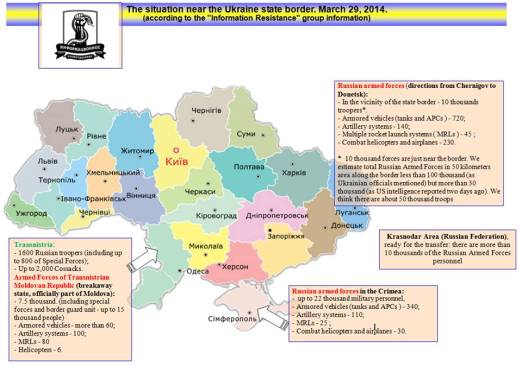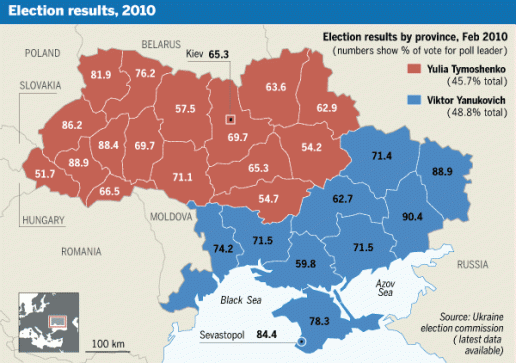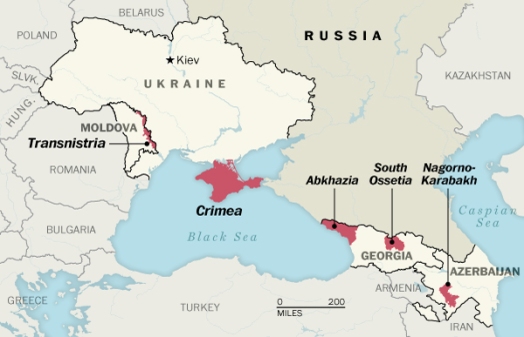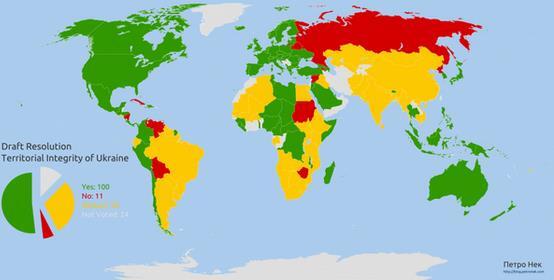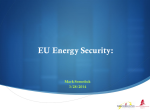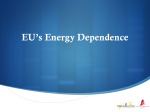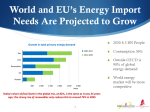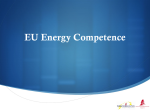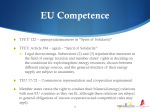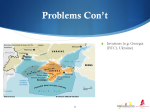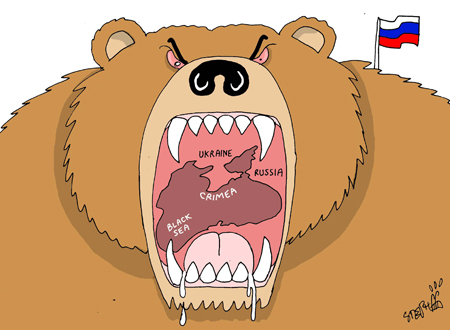Highlights of a recent presentation of mine on EU Energy Security and Russia:
Here is the full text of the draft paper (WARNING – LONG AND WONKY):
Introduction
The European Union is the world’s largest importer of oil and gas. Russia is the EU’s largest supplier. To prevent threats to EU energy security as a result of this dynamic, energy policy must become an integral part of EU external trade and foreign relations and security policy.
In order for a common energy policy to be effective, the EU must increase its competence in energy policy. This would allow the EU to speak with one voice externally, strengthen its internal energy market, and increase domestic energy production. These steps would ensure that EU citizens would be secure in the case of a crisis with Russia or other third party state energy suppliers.
Energy Needs
Growing World
Due to strong population and income growth the world’s energy needs are growing at an astounding pace. By 2030 world population is projected to reach 8.3 billion, which means an additional 1.3 billion people will need energy. As a result, world income in 2030 is expected to be roughly double its current level in real terms.
By 2030, world primary energy consumption is projected to grow by 36% (with fossil fuels accounting for over one-half of the increase) and world primary energy production is projected to keep pace. This is in part due to global energy intensity dropping by 31% by 2030[1].
Due to their rapid industrialization, urbanization and motorization, economies outside the OECD account for 90% of population growth and 70% of the global GDP growth to 2030. Together they account for over 90% of the global energy demand growth.
As a result of these trends, the world’s energy market in 2030 will be larger and more competitive. Europe will also become more dependent on external energy sources. Consequently, the European Union will be increasingly vulnerability to supply and energy price shocks.
Europe
By 2030 energy consumption in the EU is projected to increase by 15% whereas production will stagnate, causing a further increase in oil and natural gas imports. Currently, the EU energy consumption mix is predominantly oil (37%) and gas (25%) followed by coal, nuclear energy and renewable sources
The EU is the world’s largest importer of oil and gas. It buys 86% of its oil and 57% of its gas from third-party states. By 2030 imports are projected to rise to 93% for oil and 84% for gas[2]. Dependency rates vary in terms of both source and level among EU Member States. For instance, Slovakia, Poland, Hungary, and Lithuania are almost entirely depended on Russian imports.
The UK and Denmark supply just a quarter of the oil consumed in the EU. The rest is imported from Russia (30% of all oil imports), the Middle East (20%), Norway (16%), North Africa (12%), and other regions (23%). Europe’s need of oil is mainly driven by the transport sector where hardly any substitution is possible.
With only 1.3% of world natural gas reserves, slightly over one third of natural gas consumed in Europe is produced domestically[3]. The remainder needs to be imported from Russia (45% of all natural gas imports), Norway (24%), and the balance coming from the Middle East and North Africa[4]. The EU’s internal gas production peaked in 1996 and started to decline, whereas its consumption grew and still continues to increase for environmental and economic reasons (as a clean substitute to coal) [5].
Gas is mainly transported through fixed pipelines, which creates direct, long-term interdependence between the producer and the buyer. Consequently, there is no global gas market but rather regional markets, even though the development of liquefied natural gas (LNG) may change the situation in the future
Accounting for just 8.5% of primary energy consumption, renewable energy sources play a modest role in the EU, but much more potential could be exploited. The most developed forms of renewable are biomass, hydropower – especially in the Nordic, Alpine and Iberian Mountains – and, to a lesser extent, wind power (especially in Germany and Spain), geothermal (in Italy) and solar power[6].
In terms of (secondary energy) electricity production, conventional thermal accounts for 57.7%, nuclear accounts for 18%, and renewables account for 24.1%. However, the mix of energy production is quite different from country to country. Electricity from conventional thermal dominates in Germany, Italy, and the UK; nuclear power accounts for almost 80% of electricity production in France and for half of national consumption in Germany, Spain, and the UK, while countries such as Italy, Portugal, Denmark have banned nuclear generation. Renewables have been growing especially in Austria, Germany, Sweden, Latvia, Romania and Denmark[7].
Rising demand for energy at global scale and insufficient competition in EU energy markets has sustained high commodity prices. In 2012, Europe’s oil and gas import bill amounted to more than €400 billion representing some 3.1 % of EU GDP compared to around €180 billion on average in the period 1990-2011[8].
Energy Security
Principle
Energy security is the stable, uninterrupted supply of energy at affordable prices. The Commission has defined it as follows: “Energy supply security (is geared towards)…the proper functioning of the economy, the uninterrupted physical availability…at a price which is affordable…while respecting environmental concerns…Security of supply does not seek to maximize energy self-sufficiency or to minimize dependence, but aims to reduce the risks linked to such dependence[9].” The Commission has also noted that the risk of supply failure associated with increasing dependency on imported hydrocarbons is growing[10].
European Union energy policy commentators generally see how energy policy should be formulated within one of two world views.
One world view seeks to secure supply through political and economic integration in a multilateral world by increasing the influence of effective institutions and markets. The economic “markets and institutions” approach to energy security assumes that energy flows are regulated by the markets which are themselves framed by international institutions. This worldview suggests that to ensure energy security the EU should seek to strengthen global institutions and market forces.
Conversely, the other world view sees a world broken up in rival political and economic blocks, competing for resources and markets via political, economic and military power. The “Regions and Empire” scenario foresees the future of energy security issues through a “division of the world into countries and regions, on the basis of ideology, religion and political arguments”. The main underpinnings of this vision are the absence of effective international markets combined with highly integrated energy companies operating on a national basis. This worldview suggests that to ensure energy security the EU should seek energy from counties aligned with EU values.
These storylines have a significant impact on the development of the energy market, on the way in which energy supply may be secured and on the effect and applicability of the several types of instruments available. Analyzed through this paradigm, three periods in the EU energy producer-consumer relationship can roughly be distinguished. It is likely that we are entering into a fourth.
The first period, characterized by strengthening international markets and ties, started with the first oil discoveries in the late 19th century. It was characterized by the domination of Western international oil companies over energy resources and lasted approximately until the 1970s.
The second period, characterized by a greater energy regionalization, embodied a greater control of energy-producing countries over their resources. This period was highlighted by the creation of OPEC in 1960 and the oil embargo in 1973.
The third period, which characterized a return to strengthening international markets and ties, started with the dissolution of the Soviet Union, the spread of liberal values such as democracy and market economy into the post-Soviet space, and the empowerment of liberal international institutions.
During this period the European Commission started pushing to complete the European internal market. It addressed energy policy from a market liberalization perspective. Since then, internal energy market liberalization has continuously been presented by EU officials as the main tool to address European energy security concerns, including the security of supply.
The gas crises between Russia and Ukraine in 2006 and 2009 taught the EU that the traditional economic approach had reached its limits and that new policies in the energy sector were urgently needed. This challenge has been acknowledged at the EU level, as demonstrated by the 2006 Green Paper of the Commission, which recognizes the importance of “speaking with the same voice” at the international level.
The fourth period, which may have begun with the Russian invasion of Crimea, would suggest that the world is moving towards greater energy regionalization. This suggests that the EU may have to reorient its energy security policy.
In particular, Russia, which holds around 6% of the world’s oil and 23% of the world’s gas reserves, has since the election of Vladimir Putin as President in 2000 demonstrated “a growing ability and willingness to use energy as a political tool in order to pursue its political and geopolitical goals […and] strengthen its international position.”
Legislation
Energy Charter Treaty
The European Union has been working to develop a coherent energy policy since at least 1990[11]. In that year, Dutch Prime Minister Ruud Lubbers proposed a European Energy Community in an attempt to coordinate Western European trade with the suddenly and chaotically liberated markets in Eastern Europe[12].
The strategy embodied in this proposal sought to reconcile Western Europe’s interests in maintaining energy security with Eastern Europe’s interests in exporting its mineral resources. Therefore, the original intent of the agreement was to increase interdependence between the former Soviet Union and Warsaw Pact countries and Western Europe.
This proposal ultimately led to the European Energy Charter on December 17, 1991. The Charter subsequently gave way to the Energy Charter Treaty. The Energy Charter Treaty (ECT) is an international agreement which establishes a multilateral framework for cross-border co-operations in the energy industry. The treaty covers all aspects of commercial energy activities including trade, transit, investments and energy efficiency. The treaty is legally binding, including dispute resolution procedures.
The role of the Energy Charter Treaty extends beyond East-West cooperation. Through legally binding instruments it strives to promote principles of openness of global energy markets and non-discrimination to stimulate foreign direct investments and global cross-border trade. The Treaty aims to create an international trade energy regime by extending a GATT/WTO-inspired regulatory framework in the energy sector with a major emphasis on transit rules for energy networks.
The Treaty is the European Union’s primary document governing energy trade with external suppliers. Currently, fifty-one countries in Europe and Asia, and the European Union, are parties to the ECT. Notably, Russia was an observing party until October 18, 2009, at which point it effectively withdrew itself from the agreement.
The ECTs main problem is its non-ratification by Russia. Russia is able to wield more geopolitical influence by withdrawing from the ECT’s transit regime. Under the regime signatories are obliged to facilitate the gas transit on a non-discriminatory basis, which would reduce Russia’s ability to resort to political considerations while selling gas. By refusing to be bound by the ECT provisions, Russia retains the power to conclude a network of bilateral transit arrangements, providing it with a de facto quasi-monopoly of energy supply for EU gas imports.
To counter Russia’s quasi-monopoly status, the Commission, in a 2006 Green Paper, took initial steps to speak with one voice externally by identifying challenges confronting an effective external European energy policy. The Green Paper further identified priorities for the upgrading and construction of new infrastructure necessary for the security of EU energy supplies and the development of “independent gas pipeline supplies from the Caspian region, North Africa and the Middle East into the heart of the EU.” This would allow the EU to diversify energy sources thereby ensuring greater security of supply.
Treaty Provisions
TFEU 122 reads:
Without prejudice to any other procedures provided for in the Treaties, the Council, on a proposal from the Commission, may decide, in a spirit of solidarity between Member States, upon the measures appropriate to the economic situation, in particular if severe difficulties arise in the supply of certain products, notably in the area of energy.
This provision confirms the Union’s competence to adopt preventive measures to avoid security threats and may provide a basis for political backing for more far-reaching preventive measures in the future. However, with no legal obligation on the member states solidarity remains weak. A prime example in this regard is Regulation No. 994/2010/EU on the security of gas supply that was adopted at the end of 2010.
This Regulation was proposed largely in response to episodes like the Ukraine–Russia dispute, where the solidarity aspect had to be improved. While the directive leads to a more harmonized and consistent implementation of measures for the security of gas supply and a higher degree of preparedness in most member states, it achieves little regarding solidarity amongst the member states beyond what could already be done on a voluntary, bilateral basis.
EU energy policy is more directly managed by TFEU Article 194. The provision came into effect during the Lisbon Treaty and reads as follows:
1. In the context of the establishment and functioning of the internal market and with regard for the need to preserve and improve the environment, Union policy on energy shall aim, in a spirit of solidarity between Member States, to:
(a) ensure the functioning of the energy market;
(b) ensure security of energy supply in the Union;
(c) promote energy efficiency and energy saving and the development of new and renewable forms of energy; and
(d) promote the interconnection of energy networks.
2. Without prejudice to the application of other provisions of the Treaties, the European Parliament and the Council, acting in accordance with the ordinary legislative procedure, shall establish the measures necessary to achieve the objectives in paragraph 1. Such measures shall be adopted after consultation of the Economic and Social Committee and the Committee of the Regions.
Such measures shall not affect a Member State’s right to determine the conditions for exploiting its energy resources, its choice between different energy sources and the general structure of its energy supply, without prejudice to Article 192(2)(c).
3. By way of derogation from paragraph 2, the Council, acting in accordance with a special legislative procedure, shall unanimously and after consulting the European Parliament, establish the measures referred to therein when they are primarily of a fiscal nature.
From a Union perspective, Art. 194 TFEU entails prominent legal shortcomings. Subsections (2) and (3) stipulate that measures in the field of energy taxation and member states’ rights in deciding on the conditions for exploiting their energy resources, choices between different energy sources, and the general structure of their energy supply are subject to unanimity.
Further, member states retain the right to conduct their bilateral (energy) relations with non-EU countries as they see fit, although these relations are subject to general obligations of sincere cooperation and competition rules may apply.
What can be said is that the inclusion of a dedicated title and legal basis in the Lisbon Treaty formalizes the shared ownership of EU energy policy between the EU institutions and the member states in terms of “[a] carefully crafted compromise between national sovereignty over national resources and energy taxation issues, and a shared Union competence for the rest”.
The Lisbon Treaty also introduced some other notable changes that could affect the politics of energy between the Union and the member states by increasing the competence of the EU in external action.
Art. 17(1) TEU states that “[w]ith the exception of the common foreign and security policy, and other cases provided for in the Treaties, [the Commission] shall ensure the Union’s external representation.”
Further, Art. 21(2) TEU states that the Union shall define and pursue common policies and actions and shall work towards a high degree of cooperation in all fields of international relations. This includes (2f) amongst others “[h]elp [to] develop international measures to preserve and improve the quality of the environment and the sustainable management of global resources in order to ensure sustainable development.
The treaty provisions highlight that while the EU represents a quite integrated energy community internally, its member states retain their right to frame their national energy policies and merely coordinate their external energy policies.
In responding to common concerns, such as ensuring a well-functioning internal market in energy and security of supply, along with implementing the priority European infrastructure projects, the EU needs coordinated action. Currently this process entails a commitment from the institutions and the member states to European cooperation: reaching consensus on the energy targets to be achieved followed by action in the respective areas, while all work towards the same goal of delivering them.
The biggest challenge for the EU and its Member States from an institutional capacity perspective is therefore to proceed towards further integration to develop a full EU competence on energy policy that can be used externally to engage energy partners.
Russia
Background
After the collapse of the Soviet Union, Russia had a barley regulated privatization of its state resources where a handful of men came to control most of Russia’s instruments of oil and natural gas extraction and production. When Vladimir Putin came into power, one of his first steps was to nationalize Russia’s largest oil and natural gas monopolies. Companies like Gazprom, Yukos, TNK, and Rosneft all came under the control of the Kremlin after the oligarchs who owned them were exiled, incarcerated, or otherwise neutralized.
Since then, Putin has advocated for the use of Russia’s natural resources and natural resource companies to execute foreign policy strategies both related and unrelated to the country’s energy or financial goals. According to Putin, the natural resource industry is a source for much of the country’s budget, the “basis for the country’s military might,” and a source of social stability.
Putin’s strategy is therefore to exploit systemic vulnerabilities in the European Union’s government and markets to advance Russia’s foreign policy interests. This may be to the detriment of the EU’s interests. As a result of these vulnerabilities the EU faces many energy security problems.
Problems Caused by Dependence on Russian Energy
Shutdowns
Russia has shut-off gas supplies to non-Union transit countries multiple times. These regular shut-offs are highly disruptive not only to the transit countries but to the European Union itself. For example, because Belarus is not the terminus Russian pipelines, pricing disputes between Russia and Belarus threatens to disconnect downstream EU countries like Poland, Lithuania, and Germany.
Ukraine is a more disturbing and consistent victim of these shutdowns. After the Orange Revolution, Russia cut gas supplies to Ukraine after it refused to sign an agreement that would have more than quadrupled the price of natural gas, the primary source of heat for most Ukrainians. The shut-off lasted for four days. Russia did the same thing in 2009 when Gazprom sought to alleviate some of its debt problems by hiking prices in its gas contracts with Ukraine.
Shut-offs that target Ukraine are particularly disruptive to the European Union. Gas routed through Ukraine flows to the TransGas Pipeline, which leads to Slovakia, the Czech Republic, Austria, Germany, and Italy. Eighty percent of the natural gas that the European Union imports from Russia flows through Ukraine, amounting to about one-quarter of the Union’s total supply.
Russia has also shut down direct supply lines to European Union member states. In 2006, Russia closed the northern branch of the Druzhba pipeline after Lithuania privatized a major refinery by selling it to a Polish company. This action pre-empted a Russian competitor that was attempting to purchase the refinery from Lithuania.
Many observers believed that the decision to close Druzhba was a punitive action against both Lithuania and Poland. Ultimately, the Druzhba pipeline was reopened after heavily one-sided negotiations. There were no consequences to Moscow for its mineral muscle flexing. The absence of a coherent European Union voice was made evident by the incoherent member states’ positions after the matter was concluded.
Invasions
In early August 2008, Russian forces moved into the Georgian region of South Ossetia under the guise of protecting an ethnic Russian minority in that area. Georgia resisted the invasion, launching a counterattack on the Ossetian town of Tskhinvali. The counterattack was stopped, and the Russian military responded by driving far into Georgia, cutting off the primary east-west road in the country and stopping their invasion just short of the capital city of Tbilisi. A cease-fire was brokered five days after the conflict broke out.
The conflict had a number of root causes, but control over oil and gas distributions seems to have been a strong motivating factor for Russia. The invasion in 2008 came less than three years after the conclusion of the Baku-Tbilisi-Ceyhan Pipeline (“BTC Pipeline”), one of the only major pipelines from Central Asia to Europe not controlled by a Russian company.
Some infrastructure supporting the Georgian section of the BTC Pipeline came under attack during the war. Further, just two days before Russia invaded the pipeline was bombed by a Kurdish terrorist organization in Turkey.
The war itself prompted concerns in Azerbaijan and other parts of central Asia about the wisdom of involvement in any oil transit pipeline that bypassed Russia completely. This strengthens Russia’s position vis-à-vis European energy security as it chills efforts by the EU to diversify energy supply from other sources.
Influence Over Domestic Policy
The scope for political interference undermining Europe’s energy security as a result of the separate energy strategies by Member States can be exemplified by the Nord Stream gas pipeline project. The project supplies Germany with Russian gas directly by the construction of an undersea pipeline in the Baltic Sea bypassing transit states such as Poland and the Baltic states.
If Europe had spoken with one voice it is unlikely that the Nord Stream project would have been built. This is due to the extremely high costs of the undersea project compared to gas transported by land based pipelines or LNG.
This example highlights not just that Europe was unable to “speak with one voice” in the international energy market. It demonstrates how the EU lost virtually all control of its internal and external energy trade. Because Russia can threaten a shutdown of energy supplies to countries like Poland and the Baltics, while making money by selling gas directly to Germany, the domestic policy of the Union can be found to be directly under the sway of supplier countries.
Solution
There are a number of potential fixes to the weaknesses in Europe’s current energy strategy. The main step is to grant competence for the EU to formulate energy policy and negotiation all European energy deals. Such competence would allow the EU to fund infrastructure investment projects to fully integrate the internal market. Further, the EU must expand its existing plans to develop alternative energy sources to decrease dependence on external suppliers.
Putin’s strategy has limits. Russia depends on the EU to sell 80% of its oil and 96% of its gas. Its exports accounts for 20% of its GDP, providing 50% of budget revenues. If the EU is able to take these additional steps, it will significantly decrease Russia’s influence and increase EU energy security.
The first step would be for the EU to create an office or agency that handles the creation of energy policy for the entire European Union. Europe’s countries recognized the difficulties of disunited monetary policy and attempted to solve them by sacrificing control to the central government and the European Central Bank. They can certainly do the same with energy policy.
Such an office allows the European Union to actually speak with one voice in the field of energy, and to know that any policy enacted will carry with it the full weight of the Union economy, an effective counterbalance on Russian muscle flexing.
The second step would be to bar EU member states from making independent deals with outside suppliers. This would be a relatively simple solution to one of the primary issues with the current regime: Russia’s ability to divide the European Union along lines of differing member state interests and establish Russia’s desired policy with relative ease. Again, while individual states would be barred from acting independently to make deals with external supplier countries, the Union-level agency described above would be tasked with making uniform policies for the entire community.
The new policy can be enacted by the European Union under the doctrine of supremacy, which states that Union member states must set aside domestic law-even executive prerogatives granted under the constitution of the member state-when it conflicts with a treaty or law of the European Union. This policy would work hand-in-hand with the centralized agency proposal listed above-no country would be authorized to circumvent the policies lawfully entered by the central government.
By taking these two steps, the EU would Russia from pursuing divide-and-conquer strategies. It would ensure that any agreements procured with a member state by doing an end run around the central energy agency would be invalidated.
The third step would be for the central agency to invest in infrastructure on an EU wide basis. At present energy flows currently stop at member state borders because of a lack of interconnected infrastructure. Greater interconnectivity though investment in such things as bidirectional pipelines would allow energy supplies to reach all areas of the EU. This would further the economic integration of the EU.
Greater infrastructure investment and the end of the division of the European market into national segments would be a strong guarantee for the external security of supply. It would prevent foreign suppliers such as Gazprom from dividing Member States and establishing energy contracts on a bilateral basis with national companies. It would also spread the impact of a shut down over a wider area as opposed to having a severe shut down in a concentrated area.
Further, the central energy agency would be able to expand funding for existing alternative energy research and innovation programs. As mentioned above, the Union has established a number of programs and legislative directives to develop new sources of alternative energy in the European Union. These programs are designed both to foster energy independence-which helps to guarantee the security of Europe’s energy supply-and to reduce Europe’s emissions pursuant to the Union’s 2020 Energy and Climate Change goals.
Historically, legislative action by the European central government has proved an effective tool in developing renewable energy throughout the European Union. In 2001, the Union implemented a “directive on electricity product[ion] from renewable energy sources.” The purpose of the act is simply to encourage the development of renewable electricity generation and “create a basis for a future Community framework thereof.”
The Directive requires the Commission-not an independent agency-to establish national goals for each EU member state. The overall goal set by the directive was an increase in market share for renewables to 21% of energy consumption across the entire Union. By 2009, the Union had already increased the share of renewables to 19.9%, demonstrating the success the Union has had with implementing change through legislative action. This type of central government goal-setting could also be extremely helpful when solving the problem of foreign involvement in member countries’ domestic policy formation.
Research encouragement policies have been somewhat less successful, despite their utility in demonstrating the ambitions of the Union as a whole. The Strategic Energy Technologies (“SET”) plan is one of the Union’s leading innovation programs in the area of alternative energy; the Union refers to it as “the technology pillar of the European Union’s energy and climate policy.”
A recent task force report by the Centre for European Policy Studies suggests that the program has gone little farther than demonstrating its ambitions. The report states optimistically that the Plan “has the potential to accelerate the rate of innovation” with EU support. It also suggests however that the Plan has not yet done so and will not be able to without more active leadership by the European Commission.
Shale gas and oil are propelling America to energy self-sufficiency and giving its economy a handy boost. Europe’s shale-gas deposits are said almost to match those across the Atlantic (see map). However, it is too early to tell whether Europe’s shale beds will really prove as bountiful as America’s. Only a handful of test wells have been sunk. Exxon may have quit Poland, the country where exploration has gone furthest, but other firms are having more joy. Determining which countries might enjoy a bonanza of cheap gas is highly speculative, a recent report by Deutsche Bank points out: many things are in flux, including extraction technologies and production rates.
Adding to the guesswork is a host of problems “above ground”, particularly in Western Europe. With the exception of Britain, which recently lifted a moratorium on test drilling, progress is slow. The French are implacably opposed to shale gas. French environmentalists have taken a particular dislike to “fracking”, the technique for releasing gas from rock beds that uses a cocktail of chemicals, sand and high-pressure water. François Hollande, France’s president, has promised that a fracking ban, imposed by his predecessor, would last for his entire five-year term.
The Netherlands and Luxembourg have also suspended drilling for shale gas. Attempts to do the same in Germany were defeated in parliament in December. But North Rhine-Westphalia, the country’s most promising region for shale gas, suspended fracking last September pending research on the risks involved. In Austria the cost of complying with environmental regulations makes shale gas uneconomic.
Farther east, public disapproval is not as fierce, although the Czech Republic recently introduced a moratorium, Bulgaria has one in place and Romania only recently lifted its ban. Shale gas offers the promise of jobs and revenues. Even more important, it could mitigate the heavy reliance on gas imports from Russia. Indeed, Russia signaled its disapproval as soon as the deal between Shell and Ukraine on shale gas was signed. Russia sent Ukraine a bill for $7 billion for unused gas, arguing that Ukraine is contractually obliged to pay for it.
Oil companies will send people and equipment where the ride is easiest and the deals are tastiest, which explains why drilling rigs are scarce in Europe. Nearly 1,200 of them scoot around America’s shale beds; in Poland they number only half a dozen. But even if the welcome mat is rolled out now, it will be a long time before Europe can catch up with America. It may take five years to assess whether shale gas exists in commercial quantities, another five before production starts and then a few more before shale could provide a significant addition to supplies.
Conclusion
The EU is the world’s largest energy importer. The world is growing at a rapid pace and as a result global energy markets will become more competitive. The EU’s energy security is threatened by Russia which uses its energy policy to further its foreign policy.
With Russia’s annexation of Crimea, it is possible that we are entering a fourth phase of global energy security policy. The world, which had been developing strong multinational energy institutions such as the Energy Charter Treaty, may be becoming more regionalized.
This shift in worldview may give Russia stronger influence over EU energy security. As Russia flexes its geopolitical muscle over countries such as Ukraine and Belarus, the EU may experience shutdowns. Further, the threat of war disrupting energy transit in other countries within Russia’s sphere of influence chills energy infrastructure investment. This prevents the EU from diversifying its energy supply with other countries. Finally, using a divide and conquer strategy with EU member states, Russia is able to directly influence domestic policy within individual member states.
To solve these problems, the EU must increase its competence in energy policy and strengthen its energy institutions. Either the Commission must take responsibility on energy, or better yet, an independent energy agency should be created. Member states should be prevented from negotiating external energy policy bilaterally allowing the agency to speak with one voice for Europe. Further, the agency would be able to invest in energy infrastructure on an EU wide basis uniting the European energy market. Finally, the EU should invest in alternative energy sources such as the development of shale gas.
By taking these steps, the EU will be able to ensure that its citizens have an uninterrupted supply of energy so that they can peacefully and prosperously lead their lives.
[1] BP report
[2] http://www.nbcnews.com/id/16560106/#.Uxt9U_ldWSo
[3] BP Statistics, 2007
[4] European Commission, 2008a
[5] IEA, 2007
[6] European Commission, 2008a
[7] European Commission, 2008a
[8] http://ec.europa.eu/energy/doc/2030/com_2014_15_en.pdf
[9] European Commission, 2000, p. 2
[10] European Commission, 2007
[11] Andrei Konoplyanik & Thomas Walde, Energy Charter Treaty and Its Role in International Energy, 24 J. Energy & Nat. Resources L. 524 (2006).




